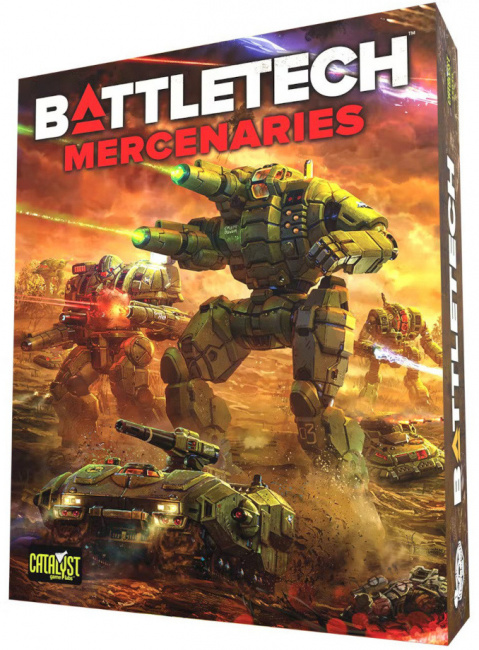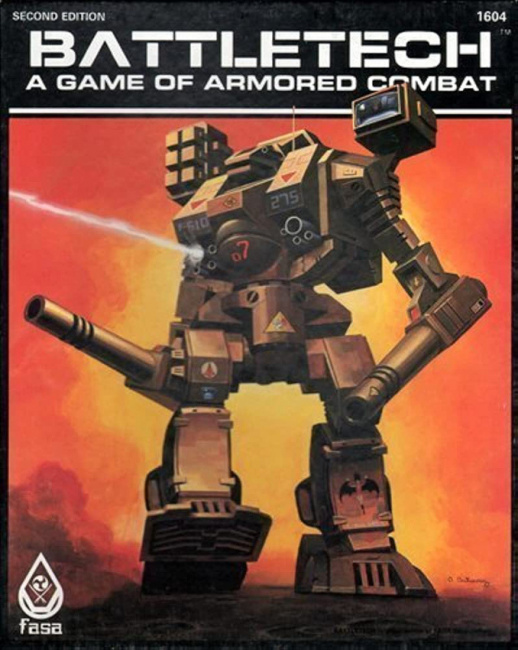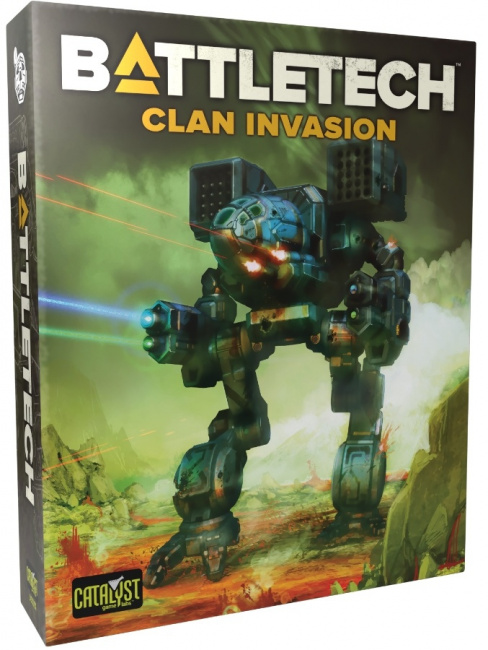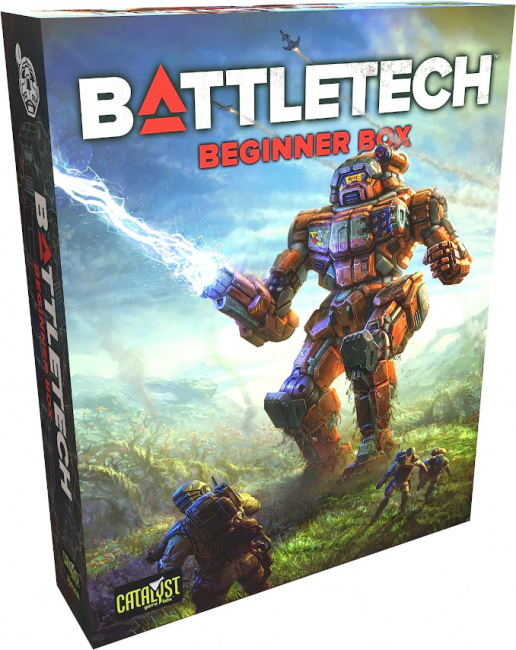We talked to Catalyst Game Labs owner Loren Coleman at AdeptiCon about the surprising renaissance in sales of the venerable BattleTech miniatures game, and discovered how Kickstarter blew up the brand, leading to a boom in trade sales.
ICv2: What we wanted to talk about was the BattleTech renaissance; Maybe you can identify how that started.
Loren Coleman: It started with the Kickstarter from 2019. It brought all the current fans, got them all excited. It brought a lot of the old fans out of the woodwork: people who had walked away or let the game lapse, or stopped reading, stopped playing for years or even decades. We had that Kickstarter with 10, 11 thousand backers/supporters who got excited about BattleTech, started playing again, and brought their friends along.
The last three years, stores reported to me that they've been almost doubling or more their player bases and their shoppers every year for BattleTech. In fact, one store reported to me this morning that their sales in 2022 were four times what they had in 2021. I credit the Kickstarter, being able to market to all of our fan base publicly at the same time; to bring out the high‑quality miniatures that we did; to give ourselves a big push deep into retail. We have put every dollar back into the brand along the way, and it's been paying off.
We opened up our second Kickstarter campaign yesterday (see "Catalyst Launches Kickstarter"), so almost three‑and‑a‑half years later, in one day, we were almost at $4 million and 14,000 backers. Apparently, there was a lot more. BattleTech's not even at the top of its game yet. There's still more mountain to climb.
Give us a little background. How old is BattleTech?
It'll be 40 years next year. This is 39.
Over those four decades, what was the ebb and flow of the game?
Well, the FASA years were the golden years. It was new. It was being promoted. They had plastics for a while, then they had to dial back out of plastics in the boxed set, which I think did hurt sales, while FASA was still running the brand. Then FASA closed its doors.
That was late 90s?
Late 90s. Then FASA closed its doors, and BattleTech nearly died, or at least it looked like it was gone. FanPro ran it for a while. Then WizKids picked it up. Then Topps picked it up. Somewhere in there with WizKids and Topps, they asked me to form a company to basically bring it back (see "Catalyst Now Has BattleTech").
It was being run at the lowest possible support level: not a lot of money, no marketing. The thinking here for years was, "Oh, BattleTech? That's still around?" I'm like, "It had never left." There was a huge dip where it felt like it was just going out of the market. We were bringing it back fairly strongly but slowly. Then we had that Kickstarter, and it just took off like a rocket.
How did you reach lapsed fans when you did the Kickstarter?
The nice thing about Kickstarter and crowdfunding in general is that the platform does the work for you. The people who get involved want to see you hit its thresholds. They want to see it succeed. They go and call up their friends, they put it on their Facebook pages, they promote it.
We did a lot of work on our social media, but really, it was just the fact that it was on a crowdfunding platform that gave people immediate access to shopping, to making their purchases, getting excited again, and start playing again.
What were the key new product releases then from the Kickstarter or since? What's happening this year?
Well, the first Kickstarter was the Clan Invasion theme, which we did the Clan Invasion Box Set, which expanded the BattleTech Game of Armored Combat. We did, I believe, 17 or 18 ForcePacks, which are 4- or 5-mech packages of the plastic miniatures, some books, and some other fun merchandise. That's been doing well for three years. They're still selling very strong in the market.
At trade, you're talking about?
In the hobby trade, absolutely. Then this year with the Mercenaries Kickstarter, we had the Mercenaries Box Set. It's got another handful of great plastic miniatures in that plus rules to expand the game again a little bit more. Then we are doing another 14 or 15 ForcePacks. We just opened ForcePack number 15 today. We're about to do another one sometime in the next couple of days. We'll probably have 16, 17 ForcePacks again from this campaign. So we'll have a new box set, 15, 16, 17 new ForcePacks, and then some new books or merchandise that'll propel us into the next two years.
Will the products from the new Kickstarter start releasing this year or next year?
Oh, it'll definitely be next year. We will fulfill to our backers end of this year/beginning of next year, probably. We predicted June 2024, but things are going so smoothly at the moment that it looks like we'll fulfill very early. Backers first, then the hobby trade will be somewhere within three months after all backers are fulfilled.
Are you running pretty much all your new releases through Kickstarter now, or any of them going straight to trade?
No, no. Actually, we released, I would say, seven, eight ForcePacks and several books in the last three, four years straight to trade. The Kickstarters give us a big marketing push on a certain theme, whatever that theme is. First it was Clan Invasion. Now it's Mercenaries. Though it was a big push, there'll still be new products coming out all along.
Then on the products that you do Kick, do they end up selling more in trade, or is the Kickstarter really the bulk of the sales?
No. Actually, we sold more in trade than we sold through the Kickstarter. Our last campaign did over $2 million on Kickstarter. After the pledge manager was done, it was almost $6 million. After you take out the shipping rates, it was almost six million dollars a product. I want to say anywhere between 12-14,000 of every ForcePack was sold through the Kickstarter pledging. After the Kickstarter, in the last two‑and‑a‑half years, we have sold over 20,000 units of each ForcePack through hobby trade. Only about a third of our total sales were from that Kickstarter.
That really speaks to the missionary component of the new or the revived consumers that backed the Kickstarter. They're out finding friends to play with, and they're buying more stuff.
Absolutely. People got excited. They started playing again. It was more mechs to paint, more mechs to play with. They got their friends going. Stores invested in BattleTech again. Stores that hadn't carried BattleTech in years were suddenly carrying it again, which created more players and more sales.
No stores ever complained to me, "You're making too many products." They were like, "When can we get more? We need more."
On existing SKUs, we've heard there's been at least some spot shortages where you aren't able to fill demand completely. What's the situation there?
Mostly just when stores are doing their job really, really well. We try to time it so we're not carrying a huge amount in inventory. If we're doing a second, third, fourth printing, we try to time it so it'll come in right about the time that previous printing runs out, but then stores will suddenly go crazy. They'll sell it out two months early. We'll end up with a 30, 45‑day window. We're just waiting for the new shipment to come in.
We have not stopped printing product the entire way through. If we start running out, we're printing months ahead of time. We're noticing and getting the next print run started. Sometimes there's a month here or a month there that products can be short but not for very long.
Do you expect that situation to be the same through this year? Occasional outages but mostly in stock?
Very occasional. In the last three years, counting the last Kickstarter, we probably did 50, 60 products. At any one time, there may be one or two that are out of stock for a month or so. The problem is, when it happens, everyone notices. They don't notice the 70 products that didn't run out of stock, just the one that did.
Beginner Boxes were out for two months. Armored Combat was out for 15 days. Clan Invasion was out for maybe 20, 25 days. Most of them aren't out for very long. It's usually in weeks. Occasionally, there'll be a part that's out for a month or so.
If a retailer that hasn't been stocking BattleTech wants to start, what's the core product range that they need to have?
The minimum, I would say, is the Beginner Box, the Game of Armored Combat Main Box, and then at least a half dozen ForcePacks. Maybe a half dozen of the core rule books to those who want to expand, like Total Warfare, the Tech Readouts, some of the plot books like Tamar Rising, or something like that. No matter where they are in their gaming process, there's something for everyone in their store.
After that, you would go to the Clan Invasion Box Set, more ForcePacks, more books. We're not saying to people at stores, "You must order a hundred products just to start with." You start with as few as 5 to 10. Then you'd be serving your customers very well. Then, as you see what you have as a customer base, you can dig in deeper.
Who was the original designer?
Jordan Weisman was the founder of BattleTech, the founder of FASA, and still a good friend to this day. We talk, and he supports our efforts. We work together on projects together. I really, really appreciate Jordan because, without BattleTech and Shadowrun, my career would look very, very different. They've both been very large in my career.
Any game that lasts 40 years is pretty impressive.
There's a lot of games on the market that are 30, 40 years old. To have this kind of excitement going after 40 years is just crazy. Our anniversary year next year's going to be very wild. We're planning a lot of fun stuff for the anniversary year for our celebration, because BattleTech deserves it. It is one of the longest-running military‑science‑fiction IPs that's ever existed.
For more ICv2 Miniatures Week news and features, click here.

The 'BattleTech' Renaissance: How Kickstarter Blew Up the Brand
Posted by Milton Griepp on March 30, 2023 @ 4:10 am CT







